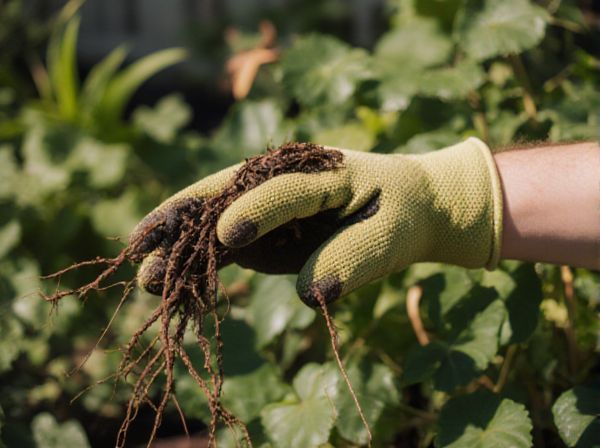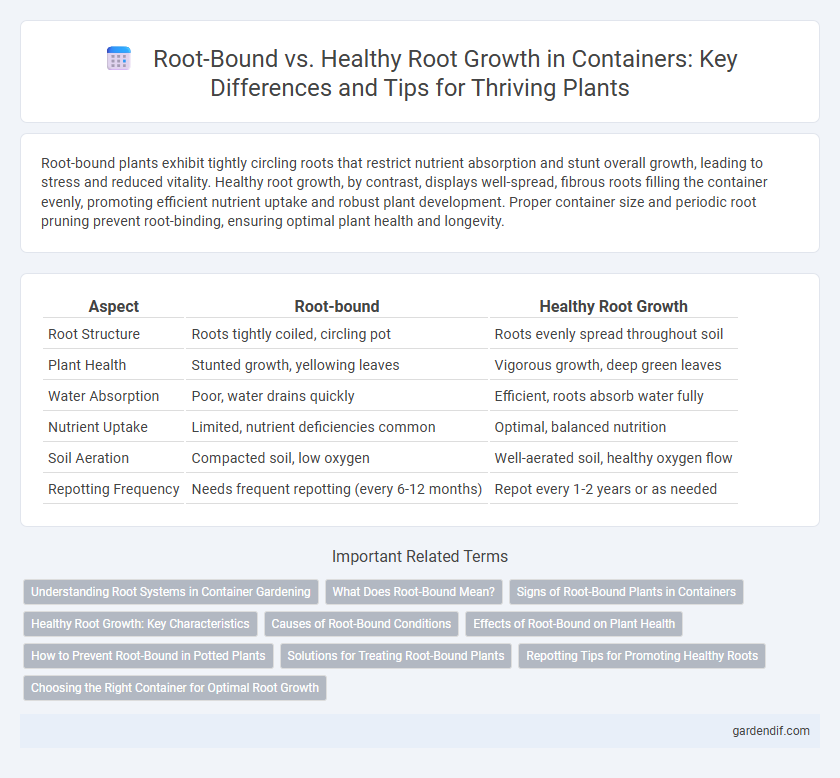
Root-bound vs healthy root growth Illustration
Root-bound plants exhibit tightly circling roots that restrict nutrient absorption and stunt overall growth, leading to stress and reduced vitality. Healthy root growth, by contrast, displays well-spread, fibrous roots filling the container evenly, promoting efficient nutrient uptake and robust plant development. Proper container size and periodic root pruning prevent root-binding, ensuring optimal plant health and longevity.
Table of Comparison
| Aspect | Root-bound | Healthy Root Growth |
|---|---|---|
| Root Structure | Roots tightly coiled, circling pot | Roots evenly spread throughout soil |
| Plant Health | Stunted growth, yellowing leaves | Vigorous growth, deep green leaves |
| Water Absorption | Poor, water drains quickly | Efficient, roots absorb water fully |
| Nutrient Uptake | Limited, nutrient deficiencies common | Optimal, balanced nutrition |
| Soil Aeration | Compacted soil, low oxygen | Well-aerated soil, healthy oxygen flow |
| Repotting Frequency | Needs frequent repotting (every 6-12 months) | Repot every 1-2 years or as needed |
Understanding Root Systems in Container Gardening
Root-bound plants in containers exhibit tightly coiled, dense root masses that restrict nutrient uptake and water absorption, leading to stunted growth. Healthy root growth shows white, fibrous roots spreading evenly throughout the soil, promoting efficient nutrient and moisture distribution essential for plant vigor. Regular repotting and proper container size selection support optimal root development and prevent root-bound conditions in container gardening.
What Does Root-Bound Mean?
Root-bound describes a condition where a plant's roots have outgrown their container, becoming densely packed and circling the pot's interior, which restricts nutrient and water absorption. Healthy root growth occurs when roots expand evenly into the soil, supporting robust plant development and stability. Recognizing root-bound signs like stunted growth or visible roots at drainage holes helps determine when repotting is necessary to restore optimal plant health.
Signs of Root-Bound Plants in Containers
Roots that circle tightly around the container's interior indicate a root-bound plant, often causing stunted growth and yellowing leaves. Signs include reduced water absorption, wilting despite adequate moisture, and roots emerging from drainage holes. These symptoms signal the need for repotting to maintain healthy root development and overall plant vitality.
Healthy Root Growth: Key Characteristics
Healthy root growth in container plants is characterized by white, firm roots that spread evenly throughout the soil, maximizing nutrient and water absorption. Roots exhibit a fibrous structure without circling or tangling, indicating adequate space and aeration within the container. These traits promote robust plant development, resistance to stress, and efficient uptake of essential minerals.
Causes of Root-Bound Conditions
Root-bound conditions occur when plant roots outgrow their containers, leading to circling and tightly packed roots that restrict nutrient and water absorption. Causes include using pots that are too small for the plant's growth rate, prolonged time in a container without repotting, and inadequate drainage that limits root expansion. Excessive root congestion stresses the plant, reducing overall health and vigor by impeding proper root respiration and moisture uptake.
Effects of Root-Bound on Plant Health
Root-bound plants exhibit restricted root growth, leading to poor nutrient absorption and reduced water uptake, which significantly stress the plant. This stress often causes yellowing leaves, stunted growth, and increased susceptibility to pests and diseases. Healthy root growth, however, ensures efficient nutrient distribution and robust plant development, promoting overall vigor and resilience.
How to Prevent Root-Bound in Potted Plants
To prevent root-bound conditions in potted plants, choose containers with adequate drainage and sufficient space for root expansion, typically repotting every 1-2 years. Incorporate root pruning by gently trimming circling roots during repotting to encourage healthy outward growth. Utilize high-quality potting soil with good aeration to promote root health and avoid compacting the root ball.
Solutions for Treating Root-Bound Plants
Treating root-bound plants requires carefully loosening the root ball to encourage healthy root expansion and prevent nutrient deficiencies. Repotting into a larger container with fresh, well-draining soil enhances aeration and water retention, promoting vigorous growth. Incorporating root stimulators and ensuring proper watering schedules helps reduce transplant shock and accelerates recovery.
Repotting Tips for Promoting Healthy Roots
Root-bound plants exhibit tightly coiled roots that restrict nutrient and water absorption, leading to stunted growth and reduced vigor. To promote healthy root growth, gently loosen potting soil and prune circling roots during repotting, ensuring the new container is slightly larger to accommodate expansion. Incorporating fresh, well-draining soil and providing consistent moisture encourages root proliferation and robust plant development.
Choosing the Right Container for Optimal Root Growth
Selecting a container with adequate depth and width is essential to prevent root binding, which occurs when roots circle tightly around the pot and restrict nutrient uptake. Containers with proper drainage and breathable materials promote healthy root aeration and water balance, encouraging robust root expansion. Choosing a container size that matches the plant's growth potential supports optimal root development and overall plant health.
Root-bound vs healthy root growth Infographic

 gardendif.com
gardendif.com